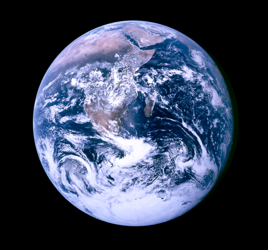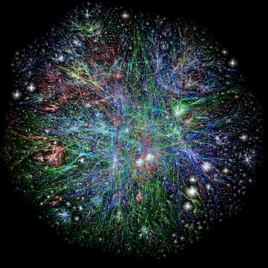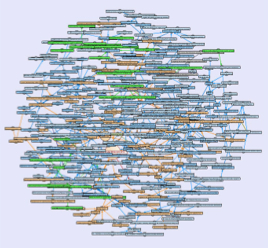Daologue
From space we see the Earth as a whole, enveloped in a thin and astonishingly beautiful layer of life; weather systems merging, ocean currents swirling, storm clouds erupting lightning, and night flowing into day across an imperceptibly fluid tectonic landscape.
What if we could see our entire planetary conversation flowing in a similar way? What might it look like? Its patterns and themes. Its streams and structures. Its forks and merges. Its bifurcating branches. Its dead ends. Its beautiful possibilities. And how might we listen and act differently given this perception of the conversation of the Earth, this enveloping planetary layer, this connecting and collecting intelligence, this sum of all dialogues: this Daologue?*
Contemplating a lifetime’s conversations, I’m struck by the degree to which our communication feels elevated – healthier – when some sense of Daologue is present: and feels diminished in its absence. Awareness of this additional dimensionality seems to encourage a Copernican shift, a softening iterative provisionality, curiosity, openness, empathy, and an attentiveness to what is not being heard; each of which strengthens our immunity to the pathology that ensues when someone or something speaking saliently to a given situation is not heard.
And yet so much of our public discourse, our party politics, our narcissistic filter bubbles, our sensationalizing media, our vituperative comment streams, feels so far adrift from this quality and possibility – a pathology growing within ourselves as well as between ourselves – and so anachronous and ill-matched to the challenging complexity of the patterns we are creating in the world.
Imbuing our public and private conversations with a greater sense of Daologue might be one of the imperatives of our age. Challenging us to become more literate in understanding and adept at working with this meta-perspective; challenging us to cultivate this awareness and quality within and between ourselves and to cultivate the spaces in which it thrives, and to develop our skills at tending to Daologue. In doing so, I wonder, too, if we might start to conceive of Daologue in its entirety as one of our most precious and uncharted resources; a commonwealth of meaning from which an ever-renewing stream of insight and innovation can be discovered, harvested and shared.
Opte Project: The Internet – 2003
The emergence of the web and our global infrastructure and real-time, social media heighten our awareness and experience of participating in a planetary conversation, and offer startling and tantalizing visual proxies for the structure and flow of Daologue. They also offer new ways to explore, develop our literacy in and empathy towards, and to work creatively with Daologue at unfamiliar scales – and to detect and parse continuously evolving signals from the continuously evolving noise.
I will expand on this theme in due course. For now though, a first step is simply to notice in wonder that our words and our inner and outer dialogues are always part of this Daologue; permutations of a kaleidoscopic pattern that is continuously forming and reforming, informing and being informed, as an astonishingly beautiful and meaningful whole.
Mapping the Contours of Thought…
[Note: This was originally published as a guest blog for the Open Knowledge Foundation – and I am blogging more frequently now at: Debategraph.us and The Independent].
Debategraph provides a novel way for geographically dispersed groups to collaborate in real-time in thinking through complex issues.
It does so by enabling groups of any size to externalise, visualize, question, and evaluate all of the considerations that anyone thinks might be relevant to the issues at hand – and by facilitating an intelligent, constructive dialogue around those issues.
Whether the group is a small team, an organization, a network of organizations, or society as a whole, the ability to augment our individual capacity to choose wisely in the face of the complex, multi-dimensional problems we confront today is ever more pressing.
Peter and I co-founded Debategraph in 2006 with the social entrepreneurial goal of creating a new form of public service communication in which the best arguments on all sides of any policy debate would freely available to all and continuously open to challenge and improvement by all.
In the iterative pursuit of this goal, we have been lucky to collaborate on a stimulating range of projects with amongst others: Amanpour on CNN, the Prime Minister’s Office, the White House open government team, The Independent newspaper, and with partners for the European Commission – with all of the public maps forming intersecting parts of a single, emerging graph of thought.
The field in which we are working with other teams is still nascent, and as pioneers together we are still exploring the two-fold challenge of making the tools as simple and natural to use as possible and of cultivating wider literacy and fluency in these structured expressions of thought.
There’s much still to be accomplished with both dimensions of this challenge; however the long-term potential that inspires us to pursue this field can be seen in two of our current projects.
In the first, we are working with the support of the UK Foreign and Commonwealth Office to develop a large scale map of the nuclear politics domain. Although the map is still in the early stages of development it already encompasses over a thousand ideas expressed from multiple perspectives – and its utility will grow significantly as the branches broaden and deepen to capture the expertise embodied in all of the relevant sub-disciplines and all of the different international perspectives on the key policy issues.
In the second, we have seeded a map with the new Coalition’s programme for government – and subsequently the Bills set out in the Queen’s Speech and the spending cuts proposed – offering a tantalising glimpse of how this collaborative mapping approach could be applied to track the entire policy agenda of the government across its full term in office.
New policy proposals can be added to the map as they emerge, and the map can track what happens when the proposals are implemented. Contradictions and inconsistencies between the measures being developed in different departments of government can be highlighted, and granular ratings can be used to signal the levels of support and opposition for the individual proposals and the salient reasons for this support or opposition.
It would fascinating, too, to begin to interconnect the map with the work being done on the Open Knowledge Foundation’s excellent Where Does My Money Go? project – as indeed it would be to interconnect the map on anthropogenic climate change with the CKAN Climate Change Group project – and if you would be interested in learning more about and/or collaborating on any aspect of our work, please don’t hesitate to get in touch.
Related articles by Zemanta
- Debategraph: Mapping the Mind of Government (independent.co.uk)
- Debategraph: Dissecting the Conservative – Liberal Democrat Coalition Agreement (independent.co.uk)
- Debategraph: Nuclear politics – where next? (independent.co.uk)
- Debategraph: Visualizing the second leaders’ debate (independent.co.uk)
- Visualizing the Prime Ministerial Debates (independent.co.uk)





